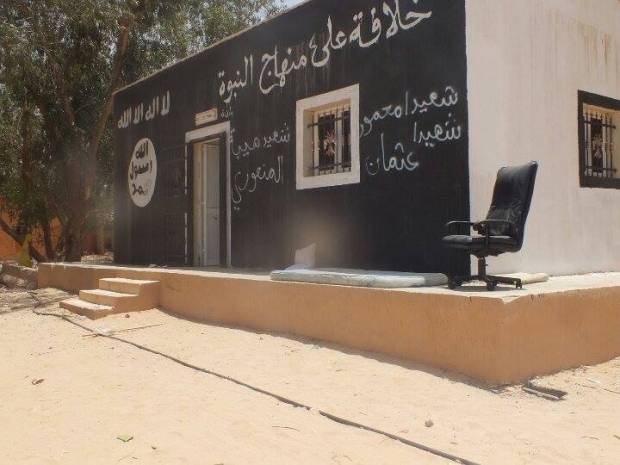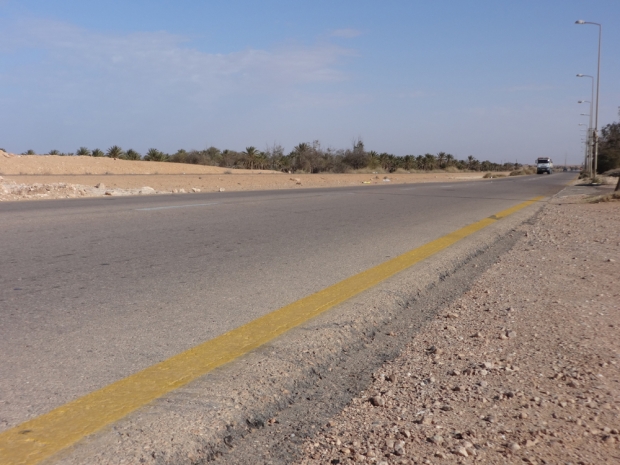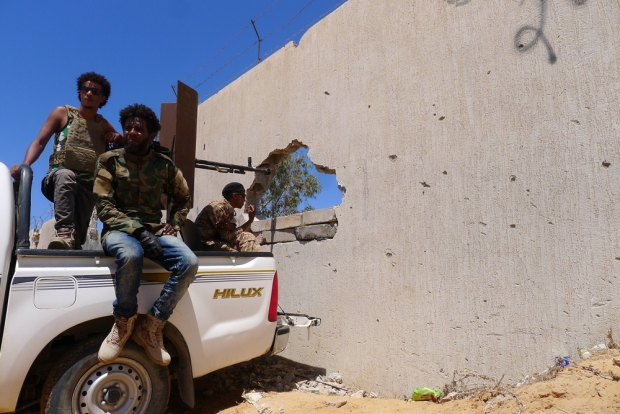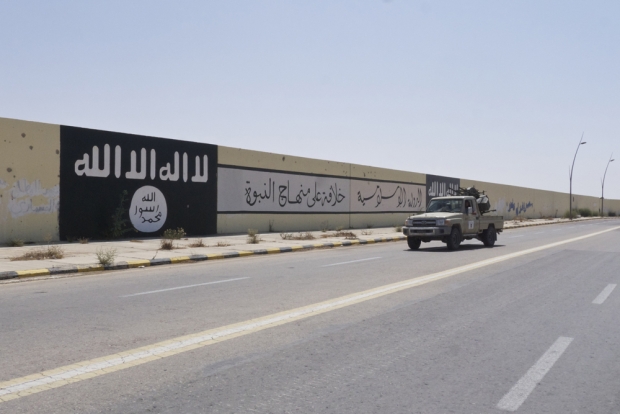'Daesh are back and want revenge': The fall and rise of IS in Libya

Libyans have described their fears of an emboldened Islamic State (IS) group reasserting itself in vast swathes of lawless territory, as the group seeks to re-establish a new power base after the fall of Mosul in Iraq and ongoing operations to end its control of Raqqa and Deir Ezzor in Syria.
Almost a year after the liberation of IS's former Mediterranean stronghold of Sirte, militants emerged over the Eid holiday, attacking an army checkpoint with a suicide car bomb and killing four soldiers. The next day, they seized temporary control of the village of Wadi al-Ahmar, 90km east of Sirte.
This Daesh guy preached there, telling us that Daesh were back and wanted revenge
- Ahmed, Wadi al-Ahmar resident
"I saw the armed vehicles outside my village and thought it was a normal checkpoint until I saw the black flag on the car, but by then it was too late for me to turn back," local resident Ahmed told MEE.
"It was Daesh. They questioned me, took my papers and then sent me to the mosque."
After abducting three local Salafi Imams who usually run the mosque, IS installed their own preacher to lead Eid prayers.
"This Sudanese Daesh guy preached there, telling us that Daesh were back and wanted revenge," said Ahmed.
"They warned us they were looking for anyone who supported the Misrata forces who kicked Daesh out of Sirte, or anyone who returned to their government or security jobs after Daesh left."
Preachers of death
When IS seized control of the area in early 2015, militants forced government and security officials to sign repentance documents and pledge allegiance to IS.
"The preacher said they have a database of people who repented and warned us that anyone who has ignored this and gone back to their normal jobs will be killed," Ahmed said.
"Normal Eid preaching should be about forgiveness and peace not killing and slaughtering."
IS militants filmed themselves in the mosque and patrolling the village in armed vehicles with a large professional video camera before leaving and heading out into the desert.
"They left at about midday but their preaching and activities were intended to send a clear message to us that Daesh are here and they are coming back. People are very scared, and some have already fled," he said.
The next evening, at dusk, IS militants returned with a fleet of some 40 armed vehicles, after cutting the electricity supply to Wadi al-Ahmar and nearby hamlets.
They established checkpoints along a 70km stretch of road which they controlled until the early hours of Sunday morning, when they were attacked by a Libyan National Army warplane, prompting them to flee back towards the desert.
Civil conflict boosts IS
The ease with which IS took temporary control over Wadi al-Ahmar exploited a security vacuum along a stretch of Libya's central coastal highway running between checkpoints operated by rival military forces loyal to competing Libyan governments.
The eastern government's Libyan National Army (LNA), commanded by Khalifa Haftar, controls Libya's central oil terminals and has theoretical control of the coastal road until just east of Sirte, after which the road is controlled by Misrata's Bunyan al-Marsous (BAM) forces, officially loyal to the UN-installed government in Tripoli.
A civilian driving from Tripoli to his hometown of Ras Lanuf to celebrate Eid al-Adha just days before IS re-emerged, reported that more than 70km of highway east of Sirte had no military presence or checkpoints, despite having formerly been controlled by IS for over a year.
"I couldn't believe it because this road is not safe at all. We know Daesh are operating to the south and regularly fire heavy weapons at vehicles driving this stretch, especially at night, so locals only use it from mid-morning until 6pm at the latest," said local resident Aimen.
Libya is Daesh's third country, and these terrorists thrive where there is conflict
- Mohammed, Sirte activist
"I felt very unsafe and drove at high speed through that area. The next day, at around 6am on Thursday, Daesh attacked the first LNA checkpoint with a suicide car bomb, killing four soldiers."
The suicide vehicle came from the direction of the small nondescript town of Nufaliya, a former al-Qaeda stronghold where IS established itself in early 2015 before seizing control of Muammar Gaddafi's former hometown of Sirte.
While LNA forces surrounded Nufaliya for 24 hours after the attack, IS shifted its attention to coastal villages lying to the west, including Wadi al-Ahmar.
Mohammed, a civil society activist from Sirte, told MEE fears were growing locally that, as IS continued to suffer territorial and personnel losses in Iraq and Syria, it was refocusing its attention on Libya, formerly its third-largest territory and the only stretch of coastline it ever controlled.
"Libya is Daesh's third country, and these terrorists thrive where there is conflict, so the ongoing war between the LNA and the Bunyan al-Marsous forces has enabled them to grow stronger here," he said.
Mohammed claimed both sides were turning a blind eye to the IS presence, hoping the militants would attack their rival forces.
"On one side, Bunyan al-Marsous forces hope Daesh will attack the LNA so they lose the oil terminals, which Bunyan al-Marsous and Misrata forces still want to control.
"On the other side, the LNA hopes that IS will start fighting Bunyan al-Marsous forces, which Haftar sees as an impediment to his ultimate plans to take control of Sirte and Tripoli."
Deja vu Daesh
Mohammed said IS's Eid activities had worrying echoes of IS's first appearance in the area in early 2015, saying it was like history repeating itself.
At its height, IS controlled Sirte and a string of towns and villages along a 200km stretch of central coastal highway, before being finally defeated by BAM forces in October 2016.
Mohammed vehemently criticised what he described as a total lack of support for those who had been subjected to IS rule, blaming this for facilitating a second wave of support for the terror group.
"Most Libyans are very religious people and remain vulnerable to IS ideologies," he said.
"No one cares about us here in this area. Even the international community doesn't come here, but important work needed to be done to de-radicalise youth and help people back to normality after Daesh.
"It was critical to re-educate people and help them to believe in democracy, to prevent IS from becoming a threat again, but this work was not done and now we are suffering the consequences."
It was critical to re-educate people to prevent IS from becoming a threat again, but this work was not done
- Mohammed, Sirte activist
Re-establishing the so-called caliphate has been on the cards since before Libya's 2016 battle for Sirte, a conflict provoked by IS itself.
From mid-2015, IS had been left in control of Sirte and some 200km of coastal territory, largely unmolested by either of Libya's main military forces.
In April 2016, IS militants launched a surprise assault on checkpoints held by Misrata forces and rapidly took ground until they were just 80km from Misrata itself.
While Misrata prepared to defend its boundaries, forming the Bunyan al-Marsous (BAM) force, which later pledged allegiance to the UN-installed government in Tripoli, Sirte locals reported that IS forces were on the move behind the front lines.
One Sirte resident told MEE in 2016 that the IS assault was not a bid to extend territory but merely a cover to enable senior IS leaders to safely flee Sirte and establish sleeper cells in outlying areas.
This claim was recently confirmed in a televised interview with a senior IS prisoner incarcerated in Misrata, Fawzi al-Ayat.
The former teacher, who travelled to Iraq and Syria in 2012 and 2013 to meet IS leader Abu Bakr al-Baghdadi, confessed that, under instruction from a Saudi Arabian IS emir, Sirte IS members facilitated the escape of 100 senior IS members from the town.
Their aim was to reinstate IS in Libya after BAM forces had liberated Sirte.
These IS personnel are believed to have relocated to a mountainous area near the town of Bani Walid, still a stronghold of Gaddafi supporters and outside the control of any Libyan government force, and the town of Emslata, situated near a mountainous nature reserve, where they regrouped and gathered support from locals disenchanted with post-Gaddafi Libya.
Sleeper cells
Locals say they have since spread their reach further south and now have an extensive network of sleeper cells across desert areas of central Libya.
In late August, IS militants executed nine soldiers and two civilians after staging an ambush on a LNA checkpoint in the al-Jufra area between Sirte and Sebha.
There are also reports of IS movement to the south of Libya's central oil export terminals. An engineer at the Ras Lanuf terminal, speaking on condition of anonymity, said security staff were "aware of IS activity" in the area.
Crude oil is being exported from the nearby Brega and Sidra terminals but oil processing plants are not yet functioning.
"These plants create very explosive petrochemical gases and, if we are attacked by Daesh, these would be very dangerous," he said.
"We won't restart them while Daesh are nearby because it would be too risky. For the moment, we will only export heavy crude which is not explosive."
We don't know what will happen next but we are expecting more attacks
- Ahmed, Wadi al-Ahmar resident
The LNA has reasserted its presence west along the coastal highway, establishing new checkpoints and arresting locals from Wadi al-Ahmar accused of being IS spies or supporters.
A fortnight ago, IS members had come to the village to refuel their vehicles and stock up on groceries, which reportedly exceeded local supplies, indicating their grocery needs had been pre-arranged with shopkeepers. Further west, BAM forces have renewed desert patrols in areas south of Sirte.
In the town of Harawa, where resilient civilians put up an extraordinary defence against IS in 2015 before being forced into submission once IS had control of Sirte, locals have established their own checkpoints manned by armed civilians, in the absence of any military support.
Smaller villages along the highway either do not have the will or capability to follow suit and remain unprotected.
"We don't know what will happen next but we are expecting more attacks," said Ahmed.
"I have to drive back to Tripoli for work but I don't believe the road is safe and I'm dreading making that journey. The way things are, IS could make a checkpoint there at any time."
This article is available in French on Middle East Eye French edition.
Middle East Eye propose une couverture et une analyse indépendantes et incomparables du Moyen-Orient, de l’Afrique du Nord et d’autres régions du monde. Pour en savoir plus sur la reprise de ce contenu et les frais qui s’appliquent, veuillez remplir ce formulaire [en anglais]. Pour en savoir plus sur MEE, cliquez ici [en anglais].








